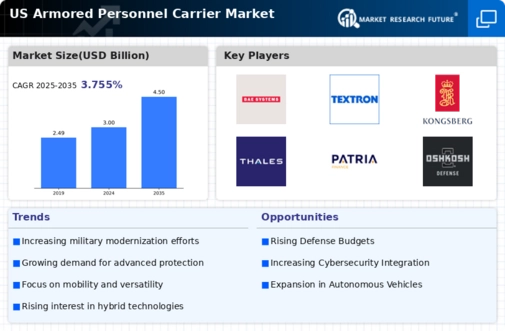The armored personnel carrier market is characterized by a competitive landscape that is increasingly shaped by technological advancements and strategic partnerships. Key players such as General Dynamics (US), BAE Systems (GB), and Oshkosh Defense (US) are at the forefront, each adopting distinct strategies to enhance their market positioning. General Dynamics (US) focuses on innovation, particularly in the development of next-generation armored vehicles, while BAE Systems (GB) emphasizes regional expansion and collaboration with local defense contractors. Oshkosh Defense (US) is leveraging digital transformation to optimize its manufacturing processes and improve supply chain efficiency. Collectively, these strategies contribute to a dynamic competitive environment, where innovation and collaboration are paramount.
In terms of business tactics, companies are increasingly localizing manufacturing to reduce costs and enhance responsiveness to market demands. Supply chain optimization remains a critical focus, particularly in light of global disruptions. The market structure appears moderately fragmented, with several key players exerting influence over various segments. This fragmentation allows for niche players to emerge, yet the collective strength of major companies shapes overall market dynamics.
In November 2025, General Dynamics (US) announced a partnership with a leading technology firm to integrate AI capabilities into its armored personnel carriers. This strategic move is likely to enhance operational efficiency and battlefield effectiveness, positioning General Dynamics (US) as a leader in the integration of advanced technologies within military vehicles. The collaboration underscores the growing importance of AI in defense applications, potentially setting a new standard for future developments in the sector.
In October 2025, BAE Systems (GB) secured a contract with the U.S. Army to supply a new fleet of armored personnel carriers, marking a significant expansion of its operational footprint in the U.S. market. This contract not only reinforces BAE Systems' (GB) commitment to meeting the evolving needs of the military but also highlights the company's strategic focus on long-term partnerships with defense agencies. Such contracts are crucial for sustaining revenue streams and enhancing competitive positioning.
In September 2025, Oshkosh Defense (US) unveiled a new manufacturing facility aimed at increasing production capacity for its armored vehicles. This investment reflects a proactive approach to meet anticipated demand and underscores the company's commitment to maintaining supply chain reliability. By enhancing production capabilities, Oshkosh Defense (US) is likely to strengthen its market position and respond more effectively to customer needs.
As of December 2025, current trends in the armored personnel carrier market are increasingly defined by digitalization, sustainability, and the integration of AI technologies. Strategic alliances are becoming more prevalent, as companies recognize the need to collaborate to stay competitive. Looking ahead, it appears that competitive differentiation will evolve from traditional price-based competition to a focus on innovation, technological advancements, and supply chain reliability. This shift may redefine how companies approach market entry and product development, emphasizing the importance of agility and responsiveness in a rapidly changing landscape.




















Leave a Comment